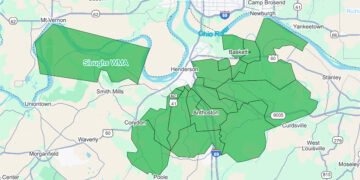COO says it’s still a plan but one with wings
Matt Reynolds, the chief operating officer of the Henderson Habitat for Humanity, said discussions this year among members of the Inner City Improvement Plan’s Housing Committee seem to always come back to one topic: “How do we get rid of blight and dilapidated houses?”
That’s the impetus that has encouraged Reynolds and the local Habitat to pitch a plan to both local governments asking for matching funds to help alleviate blight.
Reynolds said in recent memory there have always been plans and money mentioned to do something for the blighted areas in the East End—$5,000 here, $10,000 there. What’s notable about this plan, though, is the amount of money that’s involved.
Reynolds said Habitat will put up $100,000 annually for five years, a total of $500,000. The catch with the plan is that the Habitat board has stipulated there must be a matching partner, he said.
So, if the city of Henderson was agreeable, that would allow for another $500,000 over the course of five years, pushing the total to $1 million. Add on the Fiscal Court’s agreement and the funding bumps to $1.5 million.
That’s some real money–$300,000 a year for five years–that would allow for real work to get done, Reynolds said.
But as of now, it’s just a plan, and for any of it to come to fruition, there’s a lot more research needed to determine the specifics. Then, the Henderson City Commission and Henderson County Fiscal Court would need to hear the plan and vote to allocate the money, and memorandums of understanding would need to be crafted, Reynolds said.
“At this point, it’s still an idea,” he said.
But it’s an idea with some steam behind it. Henderson Mayor Brad Staton mentioned it in his state of the city address on July 25 as a goal to work toward. And in a Friday interview with the Hendersonian, Staton said the plan is a “no-brainer” for the city.
The city already allocates $50,000 a year to blight remediation, a figure that Staton said should probably be increased anyway. By pitching in $50,000 more, the city would immediately go from $50,000 to $200,000 towards blight, he said, adding that the current commission is on board.
“It is darn near a certainty that we’re going to sign on to support this,” Staton said.
He said the plan will probably be heard by the current board of commissioners.
Henderson County Judge-Executive Brad Schneider said “there certainly is a chance” that Fiscal Court will approve the plan. He said he will ask for the proposal to be presented at the next city-county cooperative work group meeting, and after that, perhaps ask that it be presented to the entire Fiscal Court for determination if “it fits in our plans.”
The money would be used to acquire run-down sites where people aren’t living, Reynolds said.
“We’re not trying to get rid of homes that people are living in,” Reynolds said.
Acquiring those sites—at least some of them—according to Reynolds and Habitat Executive Director Britney Smith will be the most difficult piece of the process.
The legal process of finding rightful owners has sometimes led Habitat officials to people living in faraway states who have not been to Henderson in decades, they said. In one case, Habitat has been working for about 10 years to acquire a property, Smith said.
On the other hand, sometimes gaining acquisition of a property is as simple as contacting an owner, viewing the residence, coming to an agreement and signing papers, Reynolds said.
Once a property is acquired, the next steps have not yet been determined. Reynolds said that most likely Habitat would take ownership and do what Habitat does—build a home.
But the organization will not seek “exclusivity” of ownership, he said. The acquired properties could end up being owned by other individuals or businesses, so long as their intent is to build new homes, businesses or apartments, he said.
Reynolds said that if the plan goes through, it will allow for Habitat to “vastly accelerate” the work it’s already doing.
The money is in Habitat’s coffers to fund this, Reynolds said.
“This is money we have,” he said. “We would not have made that commitment if we didn’t have it.”
Finally, both Reynolds and Smith said that a stigma exists about the East End, namely that residents want to get out. But that’s not true for many who grew up in the neighborhood and love the neighborhood.
“The perception that really bothers us is that people don’t want to live in the inner city,” Smith said, adding that’s not the case and instead, they simply want their neighborhood to improve.






















